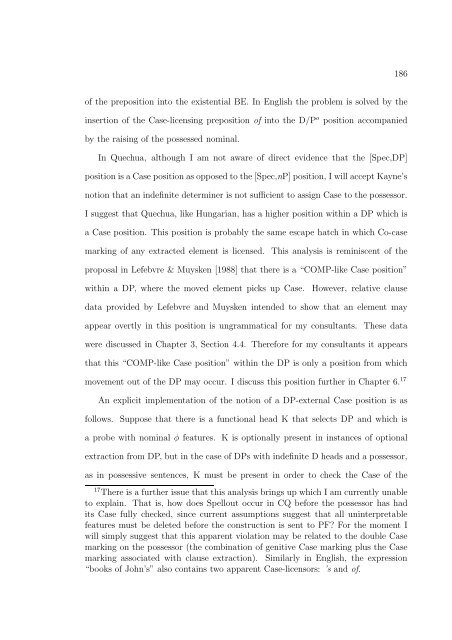the syntax and semantics of relativization and quantification
the syntax and semantics of relativization and quantification
the syntax and semantics of relativization and quantification
Create successful ePaper yourself
Turn your PDF publications into a flip-book with our unique Google optimized e-Paper software.
186<br />
<strong>of</strong> <strong>the</strong> preposition into <strong>the</strong> existential BE. In English <strong>the</strong> problem is solved by <strong>the</strong><br />
insertion <strong>of</strong> <strong>the</strong> Case-licensing preposition <strong>of</strong> into <strong>the</strong> D/P o position accompanied<br />
by <strong>the</strong> raising <strong>of</strong> <strong>the</strong> possessed nominal.<br />
In Quechua, although I am not aware <strong>of</strong> direct evidence that <strong>the</strong> [Spec,DP]<br />
position is a Case position as opposed to <strong>the</strong> [Spec,nP] position, I will accept Kayne’s<br />
notion that an indefinite determiner is not sufficient to assign Case to <strong>the</strong> possessor.<br />
I suggest that Quechua, like Hungarian, has a higher position within a DP which is<br />
a Case position. This position is probably <strong>the</strong> same escape hatch in which Co-case<br />
marking <strong>of</strong> any extracted element is licensed. This analysis is reminiscent <strong>of</strong> <strong>the</strong><br />
proposal in Lefebvre & Muysken [1988] that <strong>the</strong>re is a “COMP-like Case position”<br />
within a DP, where <strong>the</strong> moved element picks up Case. However, relative clause<br />
data provided by Lefebvre <strong>and</strong> Muysken intended to show that an element may<br />
appear overtly in this position is ungrammatical for my consultants. These data<br />
were discussed in Chapter 3, Section 4.4. Therefore for my consultants it appears<br />
that this “COMP-like Case position” within <strong>the</strong> DP is only a position from which<br />
movement out <strong>of</strong> <strong>the</strong> DP may occur. I discuss this position fur<strong>the</strong>r in Chapter 6. 17<br />
An explicit implementation <strong>of</strong> <strong>the</strong> notion <strong>of</strong> a DP-external Case position is as<br />
follows. Suppose that <strong>the</strong>re is a functional head K that selects DP <strong>and</strong> which is<br />
a probe with nominal φ features. K is optionally present in instances <strong>of</strong> optional<br />
extraction from DP, but in <strong>the</strong> case <strong>of</strong> DPs with indefinite D heads <strong>and</strong> a possessor,<br />
as in possessive sentences, K must be present in order to check <strong>the</strong> Case <strong>of</strong> <strong>the</strong><br />
17 There is a fur<strong>the</strong>r issue that this analysis brings up which I am currently unable<br />
to explain. That is, how does Spellout occur in CQ before <strong>the</strong> possessor has had<br />
its Case fully checked, since current assumptions suggest that all uninterpretable<br />
features must be deleted before <strong>the</strong> construction is sent to PF? For <strong>the</strong> moment I<br />
will simply suggest that this apparent violation may be related to <strong>the</strong> double Case<br />
marking on <strong>the</strong> possessor (<strong>the</strong> combination <strong>of</strong> genitive Case marking plus <strong>the</strong> Case<br />
marking associated with clause extraction). Similarly in English, <strong>the</strong> expression<br />
“books <strong>of</strong> John’s” also contains two apparent Case-licensors: ’s <strong>and</strong> <strong>of</strong>.
















